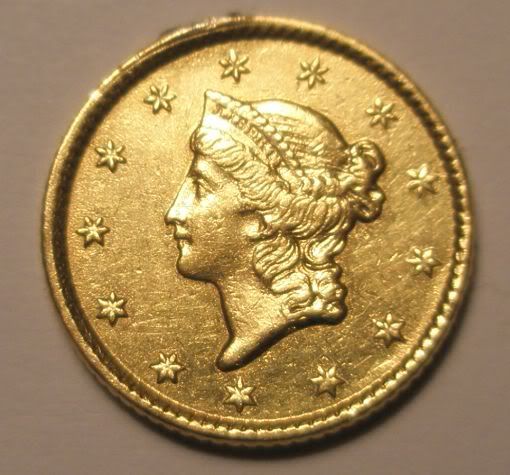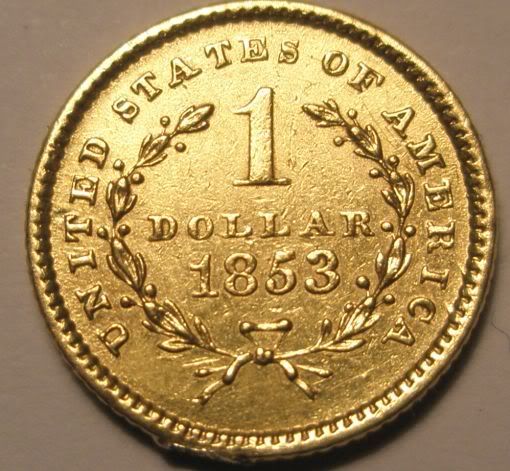1853 gold dollar. genuine?
Hello,
This is a raw 1853 gold dollar that was posted on another forum by one of the members, so this is not my coin. He was curious what the coin graded. My question is whether or not this coin is genuine. I have been studying the Bill Fivaz gold counterfeit guide lately, and based on my findings, there appears to be several questionable areas on this coin. Most notibly the two spikes coming out of the dentils on the reverse at 4 oclock, and a raised blemish as well. I know that genuine coins also may possess raised lines in the form of die cracks and die polish lines, but am I correct in thinking that the ones in this photo are suspect? I am interested in more expert opinions, as I am not one. I am posting this as a learning experience for myself, and also to be able to inform the owner as to whether or not he should return the coin and be refunded. I hope that I am wrong for the owners sake.
pics:


thanks,
John
This is a raw 1853 gold dollar that was posted on another forum by one of the members, so this is not my coin. He was curious what the coin graded. My question is whether or not this coin is genuine. I have been studying the Bill Fivaz gold counterfeit guide lately, and based on my findings, there appears to be several questionable areas on this coin. Most notibly the two spikes coming out of the dentils on the reverse at 4 oclock, and a raised blemish as well. I know that genuine coins also may possess raised lines in the form of die cracks and die polish lines, but am I correct in thinking that the ones in this photo are suspect? I am interested in more expert opinions, as I am not one. I am posting this as a learning experience for myself, and also to be able to inform the owner as to whether or not he should return the coin and be refunded. I hope that I am wrong for the owners sake.
pics:


thanks,
John
All coins kept in safety deposit box.
0
Comments
Worry is the interest you pay on a debt you may not owe.
"Paper money eventually returns to its intrinsic value---zero."----Voltaire
"Everything you say should be true, but not everything true should be said."----Voltaire
Value? If genuine, with that damage....very low end of the scale. $150 or so?
link
I have an 1852 that looks very similar to the coin linked above. Yours does looks to have broader and more rounded details but that could just be from wear. I would guess its genuine.
Since it appears to be from jewelry I would think that it wasnt made into jewelry recently and back when it was maybe counterfeiting this coin didnt happen or wasnt common.
As for authenticity, I'm not sure. If I had to figure it out from the picture, I'd try to find a picture of a real 1853 dollar with the same spikes. If it can't be found, this one's probably fake.
Doggedly collecting coins of the Central American Republic.
Visit the Society of US Pattern Collectors at USPatterns.com.
<< <i>I agree that the spikes are suspicious, and the lettering has that fat, rounded look that does not bode well.
Spikes from the denticles usually indicate a counterfeit but not always. Coin looks very suspicious. The edge at 12:00 obv and 6:00 rev indicates that it may have had a loop removed from jewelry use. Also, this coin has been heavily hairlined from a harsh cleaning. . >>
I agree. According to the Fivz book page 5, approximately 3% of coins seen with spikes are actually genuine specimens. If these are spikes, not very good odds, but still possible.
Ambro,
you say that you see none of the diagnostics of a counterfeit on this coin. Do you believe that the raised lines on the reverse rim at 4 oclock are "not" spikes? If not, then what are they? Would you consider these die cracks? How can you tell the difference. They look like spikes to me, but I'm learning here and would love to be able to distinguish between counterfeit "spikes" and genuine die cracks/polish lines.
thanks,
John
I agree that this coin is ex-jewelry which would lower its value to a significant extent. It looks like a loop was removed especially in the area of 6:30 on the reverse.
As to the question of authenticity, it’s a tough call. It’s certainly sharper than most fakes, the dentiles and the spikes coming out them on the reverse bother me.
I dont think youll ever find a counterfeit with a die clash..but then on coins like the OP with worn surfaces you may not SEE them.
<< <i>Personally, with the jewelry thing going on, and being the most common date gold dollar, the only purpose anacs would serve it to see if it is counterfeit. Having a TPG slab with a 53 that says ex jewelry wont make it any more valuable than if it was raw, it will just say its genuine. >>
Agree. Not worth the expense to slab it, even in the "GENUINE" plastic bodybag.
Worry is the interest you pay on a debt you may not owe.
"Paper money eventually returns to its intrinsic value---zero."----Voltaire
"Everything you say should be true, but not everything true should be said."----Voltaire
It's really hard to say though for sure..send it into PCGS/NGC and see what happens..if it's counterfeit, you may want to donate it to the ANA. They use counterfeit coins that are donated to them for their classes.